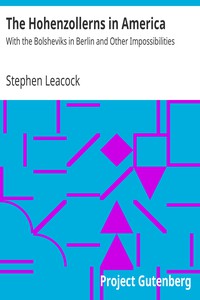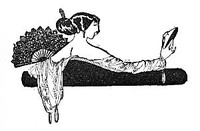The Hohenzollerns in America<br />With the Bolsheviks in Berlin and Other Impossibilities by Stephen Leacock (best memoirs of all time TXT) 📖

- Author: Stephen Leacock
Book online «The Hohenzollerns in America<br />With the Bolsheviks in Berlin and Other Impossibilities by Stephen Leacock (best memoirs of all time TXT) 📖». Author Stephen Leacock
But let that pass. At any rate it is something that everybody is saying and thinking. All our educators have turned their brains towards the possibility of utilising moving pictures for the purpose of education. It is being freely said that history and geography, and even arithmetic, instead of being taught by the slow and painful process of books and memory, can be imparted through the eye.
I had no sooner heard of this idea than I became impassioned to put it into practice. I have therefore prepared, or am preparing, a film, especially designed for the elementary classes of our schools to narrate the story of the discovery of America.
This I should like the reader to sit and see with me, in the eye of his imagination. But let me first give the plain, unvarnished account of the discovery of America as I took it from one of our school histories.
"Christopher Columbus, otherwise Christoforo Colombo, the celebrated discoverer of America, was born of poor but honest parents in the Italian city of Genoa. His mother, Teresa Colombo, seems to have been a woman of great piety and intelligence. Of his father, Bartolomeo Colombo, nothing is recorded. From his earliest youth the boy Christopher developed a passion for mathematics, astronomy, geodesy, and the other sciences of the day..."But, no,—stop! I am going too fast. The reader will get it better if we turn it into pictures bit by bit as we go on. Let the reader therefore imagine himself seated before the curtain in the lighted theatre. All ready? Very good. Let the music begin—Star Spangled Banner, please—flip off the lights. Now then.
DISCOVERY OF AMERICA AUTHORIZED BY THE BOARD OF CENSORS OF NEW YORK STATE
There we are. That gives the child the correct historical background right away. Now what goes on next? Let me see. Ah, yes, of course. We throw an announcement on the screen, thus.
CHRISTOPHER COLUMBUS.. Mr. Quinn
Here the face of Mr. Quinn (in a bowler hat) is thrown on the screen and fades out again.
We follow him up with
SPIRIT OF AMERICA.. Miss E. Dickenson
Now, we are ready to begin in earnest. Let us make the scenario together. First idea to be expressed:
"Christopher Columbus was the son of poor but honest parents."
This might seem difficult to a beginner, but to those of us who frequent the movies it is nothing. The reel spins and we see—a narrow room—(it is always narrow in the movies)—to indicate straitened circumstances—cardboard furniture—high chairs with carved backs—two cardboard beams across the ceiling (all this means the Middle Ages)—a long dinner table—all the little Columbuses seated at it—Teresa Colombo cutting bread at one end of it—gives a slice to each, one slice (that means poverty in the movies)—Teresa rolls her eyes up—all the little children put their hands together and say grace (this registers honesty). The thing is done. Let us turn back to the history book and see what is to be put in next.
"...The father of Christopher, Bartolomeo Colombo, was a man of no especial talent of whom nothing is recorded."
That's easy. First we announce him on the screen:
BARTOLOMEO COLOMBO.. Mr. Henderson
Then we stick him on the film on a corner of the room, leaning up against the cardboard clock and looking at the children. This attitude in the movies always indicates a secondary character of no importance. His business is to look at the others and to indicate forgetfulness of self, incompetence, unimportance, vacuity, simplicity. Note how this differs from the attitudes of important characters. If a movie character—one of importance—is plotting or scheming, he seats himself at a little round table, drums on it with his fingers, and half closes one eye. If he is being talked to, or having a letter or document or telegram read to him, he stands "facing full" and working his features up and down to indicate emotion sweeping over them. If he is being "exposed" (which is done by pointing fingers at him), he hunches up like a snake in an angle of the room with both eyes half shut and his mouth set as if he had just eaten a lemon. But if he has none of these things to express and is only in the scene as a background for the others, then he goes over and leans in an easy attitude against the tall cardboard clock.
That then is the place for Bartolomeo Colombo. To the clock with him.
Now what comes next?
"...The young Christopher developed at an early age a passion for study, and especially for astronomy, geometry, geodesy, and the exact science of the day."
Quite easy. On spins the film. Young Christopher in a garret room (all movie study is done in garrets). The cardboard ceiling slopes within six inches of his head. This shows that the boy never rises from his books. He can't. On a table in front of him is a little globe and a pair of compasses. Christopher spins the globe round. Then he makes two circles with the compasses, one after the other, very carefully. This is the recognised movie symbol for mathematical research.
So there we have Christopher—poor, honest, studious, full of circles.
Now to the book again.
"...The young Columbus received his education at the monastery of the Franciscan monks at Genoa. Here he spent seven years."
Yes, but we can put that on the screen in seven seconds.
Turn on the film.
Movie Monastery—exterior, done in grey cardboard—ding, dong, ding, dong (man in the orchestra with triangle and stick)—procession of movie friars—faces more like thugs, but never mind—they are friars because they walk two and two in a procession, singing out of hymn books.
Now for the book again.
"...Fra Giacomo, the prior of the monastery, delighted with the boy's progress, encourages his studies."
Wait a minute.
FRA GIACOMO... Mr. Edward Sims
Mr. Sims's face, clean-shaved under a round hat fades in and out. Then the picture goes on. Movie monastery interior—young Christopher, still at a table with compasses—benevolent friar bending over him—Christopher turns the compasses and looks up with a what-do-you-know-about-that look—astonishment and delight of friar (registered by opening his eyes like a bull frog). All this shows study, progress, application. The friars are delighted with the boy.
"...Christopher, after seven years of study, reaches the firm conviction that the world is round."
Picture. Christopher—with his globe—jumps up from table—passes his fingers round and round the globe—registers the joy of invention—seats himself at table and draws circles with his compasses furiously. He fades out.
"...Fired with his discovery Christopher sets out from the monastery."
Stop a minute, this is a little hard. Fired. How can we show Christopher





Comments (0)